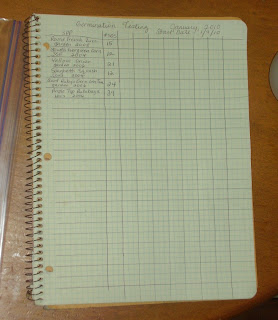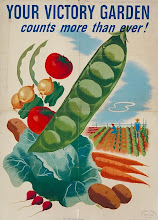The garden seed catalogs have started to arrive, so I've decided it's time to take a good look at my present seed situation. I've got a dormitory refrigerator filled to bursting with saved and purchased seeds downstairs. Before I order any new varieties I should really clean out my inventory.
Part of that clean-out is throwing away bad seed. But how do you know if seed is bad or not? How do you know if that packet of Chiogga beets you bought four years ago is still good? You've got two choices. Wait until spring to plant them and hope for the best, or do germination testing.
Germination testing is very easy. And fun, at least to me. You can do germination testing with as few as ten seeds or as many as a hundred. The more seeds you use, the more accurate your test results will be. However, if you only have a hundred seeds to begin with, you probably want to use as few as possible. I generally use between twelve and twenty-five seeds.
There's probably a dozen different ways you can test for germination rates, but this is the way I do it.
Gather together your seeds, a cookie sheet, a spray bottle with water, several half-sheets of paper towels, a ziploc bag, a ball point pen and some paper for recording.

Take a sheet of paper towel and write the name of the seed variety on the bottom with a ball point pen.

Now flip the paper towel so that the writing is face down, at the other end of the tray. This will make sense in a bit. Spray some water over the paper towel to dampen it. Take your seeds and spread them across the bottom of the towel. Try not to clump seeds together -- you want each seed to come in contact with the moist towel.

Now, beginning at the bottom, roll up the paper towel (and the seeds). Make sure the seeds stay inside.

When you're finished rolling, the name of the variety should be visible. Make sure the paper is fairly damp. Not oozing water damp, but pretty well saturated. Press the roll flat and slip it inside the ziploc bag.

Continue with this process for each of your seed varieties. Several varieties can go inside one bag. When you are finished, put the bag (open, not closed) in a warmish spot where it will remain undisturbed. The top of the refrigerator, or under a lamp.

Be sure to record the species, starting date, and number of seeds being tested.

The blank spaces on each row are for recording the number of sprouts when I check on them. I check on mine every three days or so. Be sure to remove the sprouted seeds at each checking, lest they die and get moldy. If the paper towels are drying out, spray on some more water. After two or three weeks have gone by, I tally up the number of sprouted seeds and do a bit of math to figure out the germination rate.
I've been doing this for a few years now and have had my share of surprises. One year I tested one-year-old Waltham butternut squash seed and four-year-old Waltham butternut squash seed. The one-year-old tested at 20% where the four-year-old tested at 80%. I've had three-year-old onion seed sprout at 95%, when all the gardening books I have say that onion seed goes bad after one year.
I'm testing a lot of seed this winter, twenty-two varieties to be exact. Like I said, I've amassed quite a collection of seed. I'll post my germination results as they come in. I'm sure you'll be on the edge of your seat!

5 comments:
Thanks Jo! Great explanation and pics!
Jo, great post! I will be bookmarking it and doing it soon!
Really good tutorial! This is the only way I've found to truly KNOW how viable your seeds are. Like you, I've had some surprises. One TEN YEAR OLD (Yup!) packed of radish seeds had excellent germination while I've found a two-year old packet of lettuce (which I can usually keep several years) that tested out about as dead as a door nail. And you're right, it's fun to do.
Wow! Even I could follow your directions! I was uber impressed! You sound so over-the-top organized...not what I would expect! I'm lovin' it! You do have a bit of the obsessive-compulsive behavior of your older sister!
Hey Liz -- you're very welcome!
Hello Erin -- thanks! It's super easy, and fun to play around with seeds in the depths of winter.
Hi Mama Pea! Ten years for radishes - congratulations! Knowing if your seeds are good certainly saves time in the spring, if you've got a bum batch.
Hey Karen! Yes, like you I do have a bit of the O-C behavior. It's in our genes, apparently! Unfortunately, with me it's mixed with a good dose of laziness, so my desires are always at odds with one another!
Post a Comment